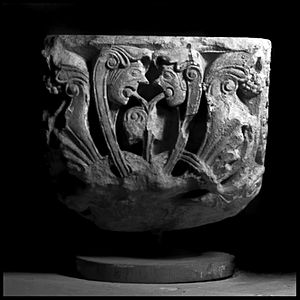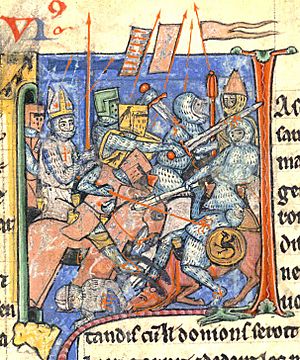Ernulf de Hesdin facts for kids
Quick facts for kids
Ernulf de Hesdin
|
|
|---|---|
| Born | Unknown Probably Hesdin
|
| Died | 1097-8 |
| Nationality | French |
| Occupation | Medieval soldier and landholder. |
| Years active | c. 1066–1097 |
Ernulf de Hesdin (died 1097) was a French knight. He was also known as Arnulf or Ernulphe. Ernulf took part in the Norman conquest of England. He became a very rich landowner under William the Conqueror and William Rufus. His name appears often in the Domesday Book, which was a survey of land in England.
Later, he was accused of being a rebel. He then died while fighting in the First Crusade as part of the army led by Robert Curthose.
Contents
Where Ernulf Came From
Ernulf was likely born in the early 1000s in a place called Hesdin in France. This area was part of Picardy or Artois. Hesdin was a strong, walled town near the Canche river.
His family were not super rich, but they owned some land. They were like helpers, or vassals, to the Counts of Hesdin. The Counts of Hesdin, in turn, answered to the Count of Flanders.
The first known Count of Hesdin was Alulf I, around the year 1000. Later, Walter I was Count during the Norman conquest of England. Walter's successor, Engelram, was Count from 1072 to 1100. Ernulf grew up under Walter I's rule. He also had strong connections with Engelram. They often worked together and gave money to religious places.
We don't know much about Ernulf's immediate family. But he did have a brother named Ilbod. Ilbod also owned a lot of land in England, in places like Essex and Oxfordshire.
Ernulf's Life and Work
A Mysterious Person
Historians became very interested in Ernulf. This was because his daughter, Avelina, married Alan fitz Flaad. Through them, Ernulf became an ancestor of the Stewart Kings of Scotland. These kings later ruled Scotland and then England.
Even with all the research, Ernulf de Hesdin is still a bit of a mystery. We know a lot about the lands he owned. We also know about his many gifts to monasteries. But there isn't much information about his personal life. We have to guess parts of his story from other clues and old legends.
His Early Days
We don't know for sure what Ernulf did early in his life. Many people believe he was part of William the Conqueror's army. This army invaded England in 1066. One old book from 1791 said Ernulf was "one of the Conqueror's attendants."
Ernulf is also listed as a companion of William the Conqueror. This list is from a church in France. However, this list isn't always accurate. It's very likely that Ernulf fought well for William the Conqueror. Otherwise, he wouldn't have become so rich and powerful. It's possible he fought in the Battle of Hastings, but we can't prove it.
An old book called Liber Monasterii de Hyda described Ernulf later in life. It said he was "tall in stature, outstanding in activity, well-supported by possessions." This description fits someone who had a successful military career.
The Domesday Book survey found Ernulf to be a very important landowner. He held land directly from the king in ten different counties. He also controlled other estates under other powerful lords. We don't know exactly how he got so much wealth. But we do know he sometimes visited the king's court. In 1081, he gave land to Gloucester Abbey. The king himself, Queen Matilda, and other important people witnessed this gift. This shows he was a very respected person.
Working with King William Rufus
Ernulf continued to be successful when William Rufus became king (1089–1100). He was often at the royal court. He also witnessed important royal documents. For example, in 1091, he saw the king confirm John of Tours as the first Bishop of Bath and Wells.
The Fight for Normandy
Ernulf was involved in King William Rufus's efforts to take over Normandy. Normandy was mostly controlled by William the Conqueror's oldest son, Robert Curthose. In 1093, William Rufus talked with Robert I, Count of Flanders. This Count was Ernulf's boss, or "overlord." They were preparing for a military trip to Normandy.
Count Robert was helpful. He preferred to be allies with England rather than face a strong Normandy. But he died soon after. His son, Robert II, took over. He was less keen on helping.
Engelram and his knights, including Ernulf, got ready for war. They made gifts to religious places, especially the Priory of St George near Hesdin. Count Robert agreed to protect these gifts during the war.
William Rufus's invasion was delayed until 1094. Then, the King of France, Philip I of France, helped Robert Curthose. William Rufus paid Philip to stop fighting. By autumn, the fighting ended without a clear winner. William Rufus then went back to England. Ernulf went with him, stopping at Hesdin. There, he confirmed his gifts to the Priory of St George. This included all the lands he held under Engelram at Hesdin.
A Big Problem and the Crusade
In 1095, some powerful lords rebelled against King William Rufus. Ernulf was accused of being part of this plot. But an old book from Hyde Abbey said he was innocent.
According to this old story, Ernulf had a champion fight for him in a trial by combat. Ernulf's champion won. But Ernulf was so upset by the accusation that he gave up all his lands in England. He then left the country forever. Later that year, Ernulf joined the First Crusade. He died during the Siege of Antioch. As he faced death, he refused a doctor. He said, "No doctor can reach me except he for whom I have undertaken this pilgrimage." This meant he believed only God could help him now, as he was on a holy journey.
Ernulf the Landowner
Ernulf owned land all over England. But many of his properties were grouped together. They stretched from the Cotswolds through Oxfordshire and Gloucestershire. Then they continued to the Mendip Hills in Somerset and into central Wiltshire. This area was important for the medieval English wool trade.
Sometimes, Ernulf's ownership of land was challenged. He had disagreements with the Church over some properties. For example, at Pewsey, a monastery called Hyde Abbey claimed his land. At Potterne, the Bishop of Salisbury claimed land that Ernulf had rented out. In these cases, the Church had owned the land before 1066. But somehow, Ernulf had managed to take control of it directly from the king.
Ernulf was a very important landowner. He held about 52 properties directly from the king. He also managed almost half of these himself. These included important places like Chipping Norton. He likely built a simple castle there. His family later replaced it with a stronger one.
The value of these lands varied a lot. Newbury, Berkshire was a growing town. Its value had increased a lot since 1066. Farming lands could also be very valuable. Kempsford in Gloucestershire was worth a lot of money. Most of its income came from its many village homes and farms. It even had four mills and made sheep's cheese. However, Ruislip, near London, had actually gone down in value since 1066. Even so, it had many homes, including some French settlers who might have been Ernulf's own helpers. Its forests also provided food for 1,500 pigs!
Ernulf also rented out 28 estates to other landowners. Some of these renters were French, probably from Normandy. Others were English or Norse.
He also owned property in towns. He had seven houses in Gloucester. He also owned 51 household sites in Newbury. The value of Newbury had grown a lot. This was likely because the town became a busy trading center under Ernulf's control.
Gifts to Religious Places
Ernulf was very generous with his gifts to several Benedictine monasteries. In 1080, King William I confirmed some of his own gifts to Preaux Abbey. At the same time, he confirmed gifts from his powerful lords. Ernulf had given the church at Newbury to the abbey. He also gave the priest's house, a hide of land (a measure of land), and the tithes (a part of the harvest or income).
On February 2, 1081, Ernulf gave the manor (a large estate) of Linkenholt to Gloucester Abbey. The king, queen, two princes, and church leaders witnessed this gift. The Domesday Book later recorded this land as belonging to Gloucester Abbey.
In 1094, Ernulf confirmed his gifts to St George's Priory at Hesdin. He then traveled to Chipping Norton in England. There, he confirmed more gifts to the priory. These included churches in Chipping Norton, Weston (near Bath), and Easton Piercy. He also gave two chapels in Bath. In Newbury, he gave a small piece of land. The priest would pay the priory half a mark of gold each year for it. After the priest died, the land would fully belong to the priory.
Ernulf also gave three manors to Cluny Abbey. This abbey was very important in the Church's reform movement. These manors were Tixover, Manton, and Offord. King Henry I confirmed these gifts around 1131.
Marriage and Family
Ernulf's wife was named Emmelina. This is a shorter version of the name Emma. We know this because they made many gifts to monasteries together. For example, they gave the manor of Combe to Bec Abbey.
Ernulf's Children
There's still some debate about all of Ernulf and Emmelina's children.
- Ernulf de Hesdin (Junior): This was their son, named after his father. He inherited some of his father's lands. Sadly, he was hanged in 1138 by order of King Stephen. This happened because he supported Empress Matilda during a time of civil war called the Anarchy.
- William: He and his sister Ava agreed to Ernulf's gifts to St George's Priory. He might have inherited lands in France. He was still alive in 1125.
- Avelina: Her name was a shorter version of Ava. She married Alan fitz Flaad. He was an adventurer from Brittany who became very important thanks to King Henry I. Avelina's existence was proven by historians. After Alan died, Avelina married Robert fitz Walter of Horsham.
* William FitzAlan: He was Avelina and Alan's son. He inherited Alan's lands in England. His family became the FitzAlan Earls of Arundel.
* Walter fitz Alan: He was another son of Avelina and Alan. He became the first hereditary High Steward of Scotland. He was an ancestor of the House of Stuart. This family later became the ruling kings and queens of Scotland, and then England and Ireland.
- Matilda: She married Patrick de Cadurcis, also known as Chaworth. Historians are not completely sure if Matilda was Ernulf and Emmelina's daughter. However, she and Patrick inherited a large part of Ernulf's lands. In the early 1100s, they gave a church at Toddington, Bedfordshire to an abbey. They mentioned Ernulf de Hesdin as someone who held their estates before them.



